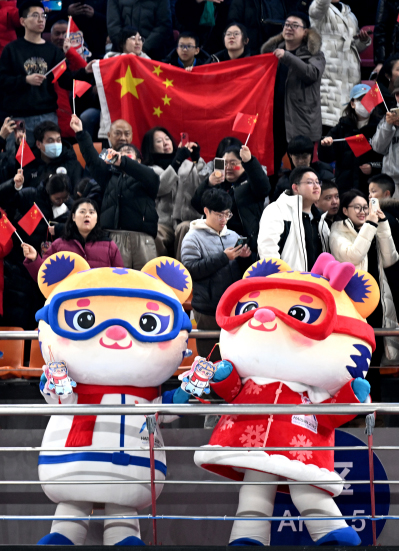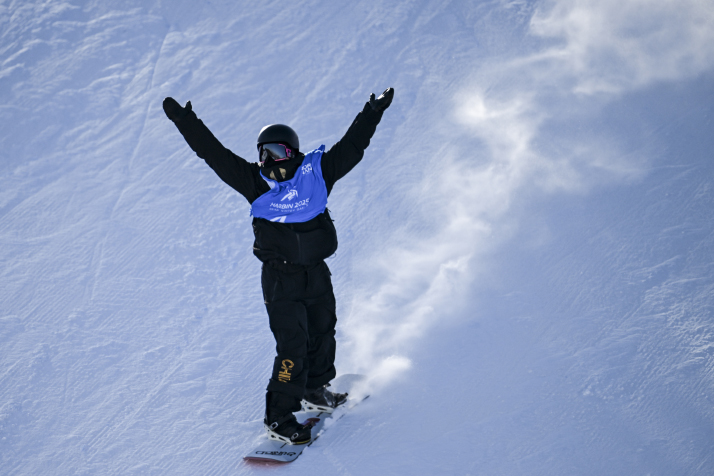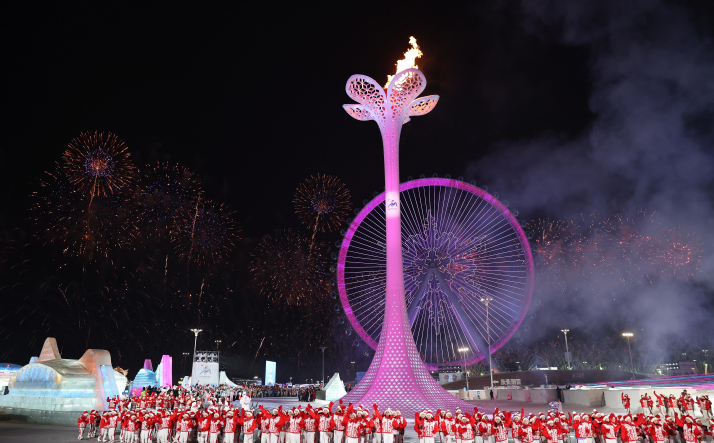
Harbin has been a hot winter tourism destination, celebrated for its ice and snow attractions and warm hospitality. This year, the city, building on its enormous popularity last year, once again took center stage with the AWG. Running from February 7 to 14, the Harbin games, under the theme “Dream of Winter, Love Among Asia,” were the first major international winter sports event hosted by China since the Beijing 2022 Olympic Winter Games (Beijing 2022).
This was also the third time that the AWG was held in China, after the one hosted by Harbin in 1996 and by Changchun in 2007. Additionally, it was the first major gathering of the Asian sports community in China after the 2023 Hangzhou Asian Games.

Record-setting gathering
From securing the hosting rights for the Ninth AWG in July 2023 to hosting its grand opening on February 7 this year, Harbin only had 580 days to prepare for this event—far shorter than the typical four to seven years required for organizing major international competitions. Vinod Kumar Tiwari, Deputy Director General of the Olympic Council of Asia (OCA), hailed this achievement as “a miracle.”
The latest AWG also stood out for introducing new official events, such as freestyle skiing women’s aerials synchro and ski mountaineering.
At the same time, the number of participating countries and regions, as well as the number of athletes, reached historical highs.
Husain Al-Musallam, Director General of the OCA, acknowledged that winter sports in Asia remain relatively concentrated, with considerable development primarily in China, Japan, South Korea, Central Asian nations, and India. However, the AWG has seen increasing participation from across the continent, showcasing the vitality and potential of winter sports in other parts of Asia.
The Harbin games saw the debut of countries including Cambodia and Saudi Arabia.
The National Olympic Committee of Cambodia sent a delegation of nine members, including athletes and coaches, to compete in the luge event. Vath Chamroeun, Secretary-General of the committee, attributed this milestone to a new International Olympic Committee policy encouraging
participation in winter sports from countries with warmer climates.
Afghanistan and Bahrain returned to the AWG after missing its eighth edition in 2017. The United Arab Emirates, participating for the third time, sent its largest-ever delegation, of seven athletes, to compete in alpine skiing, freestyle skiing, and snowboarding. Lebanon fielded its biggest delegation ever, with 17 athletes competing in five events, despite challenges in training such as limited infrastructure and scarce snowfall. Thailand made its debut in men’s and women’s ice hockey, while the number of curling teams expanding from six at the last AWG to 16 this time.
At the inaugural AWG in 1986, West Asia, Central Asia and South Asia were absent. Today, desert nations such as Oman, Qatar, Kuwait, and Saudi Arabia are sending athletes to compete, despite their lack of natural snow or mountainous terrain. Al-Musallam noted that many delegations have shown remarkable progress with each edition, underscoring the growing potential of winter sports in Asia.
He also highlighted that the 2029 AWG will be held in Trojena, Saudi Arabia, the first time the event will be hosted in West Asia. Al-Musallam expressed confidence that this will further promote the popularity of winter sports in Saudi Arabia, the Middle East, and across Asia.

Green and smart
This year’s AWG embraced a green and sustainable approach. All five ice venues and eight snow competition sites were upgraded from existing facilities, utilizing energy-efficient materials and low-carbon technologies, avoiding large-scale construction.
At the Yabuli Ski Resort, where the eight venues for snow events were located, infrastructure upgrades and artificial snowmaking were completed well in advance. Wang Mingcheng, head of the snow event venue construction project, explained, “We built 11,000 meters of snowmaking pipelines, allowing water to be pumped directly from the station to every point on the course, enabling 24-hour snow production.”
Ji Yanqi, head of the 5G Technology Innovation Center at telecommunications operator China Unicom’s Heilongjiang branch, introduced that over 10 5G technologies were showcased at this year’s AWG. Among them, 5G-A high-precision positioning technology was applied to personnel management at event venues.
By enabling the real-time tracking of staff and personnel, the technology optimized scheduling, improved efficiency, and ensured the smooth operation of all event-related tasks.
In terms of logistics management, China Unicom utilized 5G-A passive Internet of Things technology to create a 5G-enabled communication support materials storage management platform, featuring intelligent recognition and precise positioning capabilities, allowing for rapid item identification, quantity counting, and lost item retrieval. This eliminated the need for manual inventory checks, enhancing the intelligent management of event communication resources.
The Yaxue Highway, a vital route connecting the Snow Town National Forest Park and the Yabuli Ski Resort, incorporates a unique musical design feature—four sections of the road surface are designed to play music as vehicle tires move over them. Zhao Liang, General Manager of Boxian Construction Group in Heilongjiang, which participated in the highway’s construction, explained that engineers used computer modeling to create specific grooves on road surfaces, the width, spacing, and depth of which are calculated to produce melodies when the tires press on the grooves.
“We can compare the musical road to a record player, where the road surface acts as the record and the vehicle tires as the needle,” he told Guangming Daily. This innovative design not only provides drivers with a unique auditory experience but also subtly encourages them to maintain a safe speed, thereby enhancing road safety.
A stage for athletes
This AWG also set the stage for inspiring stories: seasoned athletes reclaiming their brilliance, emerging talents carving out their legacies, competitors who had once faced adversity rediscovering their confidence and reaching new pinnacles, and experienced veterans gracefully concluding their careers with a memorable finale.
Chinese athlete Yang Wenlong began his sporting journey in martial arts before successfully transitioning to snow sports. In 2016, he became one of the first athletes selected for the national team in big air and slope style. In 2021, he made history by becoming the first snowboarder in the world to successfully complete the incredibly difficult “Quad Cork 1980” maneuver.
However, this achievement also brought immense psychological pressure, leading to mistakes in subsequent competitions and ultimately costing him a spot at Beijing 2022. This setback plunged him into a period of low spirits, but he eventually regained his motivation and set his sights on the 2026 Milan Winter Olympics. Although at 25 years old he is no longer considered young in the world of big air, he remains steadfast in the pursuit of dreams.
At this year’s AWG, he secured the championship with two flawless “Quad Cork 1800” maneuvers, which not only boosted his confidence but also strengthened his resolve to aim for the top of the podium in Milan.
Short-track speed skater Sidney Chu, from Hong Kong Special Administrative Region, began his journey at the age of five with ice hockey training. After switching to short-track speed skating in 2012, he made his mark as the sole ice event representative for Hong Kong at Beijing 2022. At this year’s AWG, Team Hong Kong achieved a historic milestone by sending six athletes to compete in short-track speed skating and participating in two team events for the first time.
Although Chu did not secure a podium finish in any of his eight events at the games, he views each appearance as an opportunity to raise the profile of Hong Kong’s winter sports. “This is my first time competing in speed skating at an international event. I wanted to challenge myself because Hong Kong has almost no professional speed skaters. I hope my performance can inspire more Hong Kong residents to experience the charm of winter sports,” Chu said.
Since Beijing 2022, Chu has been promoting winter sports in Hong Kong. He has registered a company, partnered with ice rinks and taken on the role of an ambassador for speed skating in the region.
“Beijing 2022 really boosted interest in winter sports in Hong Kong,” he told Xinhua News Agency. “New ice rinks have been built, and speed skating classes have become increasingly popular.”
Witnessing the growth of winter sports in Hong Kong, Chu reflected on achieving two lifelong dreams. “As a child, I dreamed of seeing Hong Kong’s winter sports develop a structured system. Later, I hoped we could build a larger team. Now, both dreams have come true.”
Looking ahead, Chu expressed his aspirations for the next generation: “I hope to see homegrown Hong Kong ice athletes standing on the podium at international competitions.”

Post-games plan
As an important base for ice and snow sports in China, Harbin will embrace new opportunities for the development of these sports following this edition of the AWG.
The AWG venues will offer sites for not only ice and snow festival competitions and events, but also popular ice and snow leisure activities like skating, curling, and ice hockey, promoting the integration of ice and snow sports into the lives of citizens.
Wang Hesheng, Mayor of Harbin, particularly emphasized the post-event utilization plan for the venue that hosted the AWG’s opening and closing ceremonies. The venue will be transformed into a multifunctional complex that integrates trade exhibitions, public fitness events, sports competitions and commercial performances. “After the closing of this Asian Winter Games, all venues will be open to the public, playing an important role in professional training, event hosting, and the development of mass sports, continuously promoting the popularization and development of ice and snow sports,” he said. –The Daily Mail-Beijing Review news exchange item




